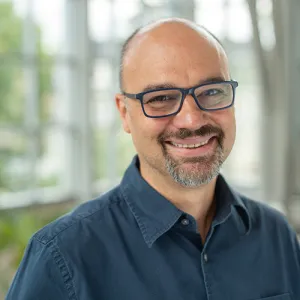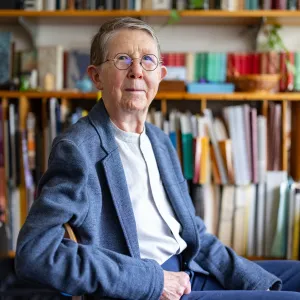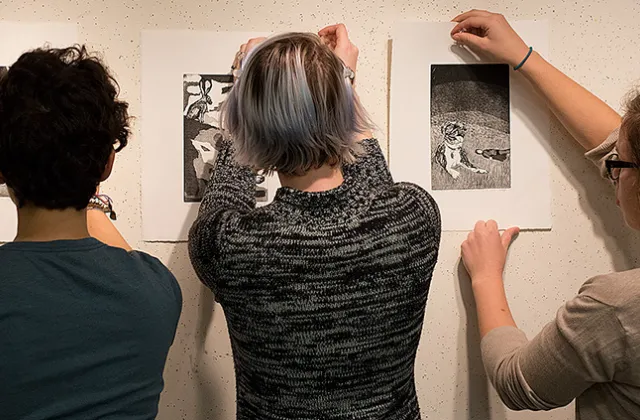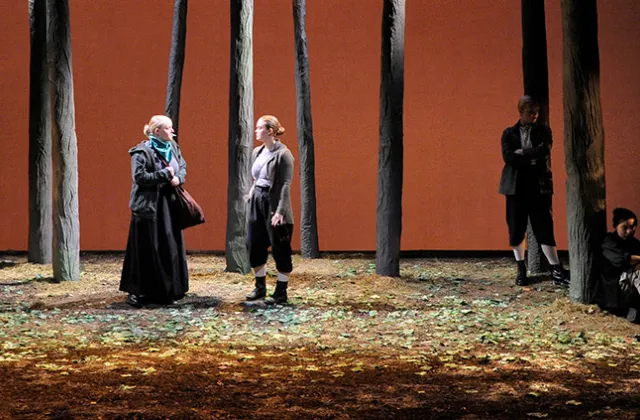
Arts & Technology Program
This interdisciplinary minor provides students with a strong foundation in media arts and technology studies, while laying the groundwork for more advanced work in this area. Two primary strengths of the minor are the broad range of topics and approaches to which students are exposed, and the individualized nature of each student’s trajectory. The field of arts & technology is by nature diverse and rapidly changing, and therefore requires broad exposure, and self-direction and high motivation from the student. We expect our students to reach a point by graduation where they can anticipate and influence emerging trends rather than merely follow them, and help create and define new aesthetics for computer media.
Requirements & Courses
Arts and Technology Minor
Requirements
Six courses
- One foundational course: ARS 162, CSC 110, SDS 192 or THE 100
- Three intermediate courses from at least two different departments
- Two 200-level or above courses
- One elective
- One elective
- One four-credit special studies on a topic approved by the minor adviser
Crosslisted Courses
ARS 162 Introduction to Digital Media (4 Credits)
An introduction to the use of digital media in the context of contemporary art practice. Students explore content development and design principles through a series of projects involving text, still image and moving image. This class involves critical discussions of studio projects in relation to contemporary art and theory. Core studio materials are provided. Students are responsible for the purchase of additional supplies required for individual projects. Enrollment limited to 14. Instructor permission required. Arts
Fall, Spring
ARS 263 Video and Time-Based Digital Media (4 Credits)
This course builds working knowledge of multimedia digital artwork through experience with a variety of software, focusing on video and time-based media. Core studio materials are provided. Students are responsible for the purchase of additional supplies required for individual projects. Enrollment limited to 14. No prerequisites. Instructor permission required. Arts
Fall
ARS 361 Interactive Digital Multimedia (4 Credits)
This course emphasizes individual and collaborative projects in computer-based interactive multimedia production. Participants extend their individual experimentation with time-based processes and development of media production skills (3D animation, video and audio production) developed in the context of interactive multimedia production for performance, installation or internet. Critical examination and discussion of contemporary examples of new media art augment this studio course. Core studio materials are provided. Students are responsible for the purchase of additional supplies required for individual projects. Prerequisite: ARS 162. Enrollment limited to 14. Instructor permission required. Arts; Mathematics
Fall, Spring, Annually
CSC 240 Computer Graphics (4 Credits)
Covers two-dimensional drawings and transformations, three-dimensional graphics, lighting and colors, game design, perspective, curves and surfaces, ray tracing. Employs Postscript, C++, GameMaker, POV-ray, and radiosity. The course accommodates both CS majors, for whom it is programming intensive, and other students with less technical expertise, by having two tracks of assignments. Prerequisite: CSC 120 or equivalent. MTH 111 or equivalent is an additional required prerequisite for majors. Designation: Theory, Programming. Enrollment limited to 30. Mathematics
Fall, Spring, Annually
EGR 100ee Topics: Engineering for Everyone-Energy and the Environment (4 Credits)
Through readings, discussion, labs and lectures, students learn about human activity related to energy usage and the consequences to Earth’s environment. This knowledge is applied to motivate, design and build scale models of net-zero energy buildings. Through simple lab exercises, students learn to program microcontrollers that measure temperatures and control features within their model buildings, and corresponding analyses enable students to demonstrate how energy from the sun can be utilized in design to reduce carbon-based energy sources. Restrictions: EGR 100 may not be repeated. Enrollment limited to 20. Natural Science
Fall, Spring, Variable
EGR 100hh Topics: Engineering for Everyone-Challenges in Human Health (4 Credits)
This course explores broadly how engineering design approaches can be used to address a variety of challenges in human health. Through readings, discussions, lab experiences, short design assignments, and a semester-long team design project, students work to identify open unmet biomedical needs and learn a process for how to develop solutions to meet those needs. The emphasis is on first gaining a thorough understanding of an unmet need and then on continually improving solution ideas, through testing and seeking feedback on the current set of possible solutions and learning from failure.Restrictions: EGR 100 may not be repeated. Enrollment limited to 20. Natural Science
Fall, Spring, Variable
EGR 100sw Topics: Engineering for Everyone-Sustainable Water Resources (4 Credits)
Students in this course investigate and design water resources infrastructure – for hydropower, water supply, wastewater treatment, stormwater management and irrigation. Those technologies are introduced through historical and contemporary examples, along with a theme of the importance of place in engineering design. In contrast to design as invention, this course puts the emphasis on the adaptation of common designs to particular places, as influenced by climate, physical geography, culture, history, economics, politics and legal frameworks. Examples include the historic Mill River, Northampton’s water resources, Boston’s Deer Island wastewater treatment facility, San Francisco’s water supply system, California’s State Water Project and the Bay-Delta system, the Colorado River and water recycling and reclamation. Restrictions: EGR 100 may not be repeated. Enrollment limited to 20. Natural Science
Fall, Spring, Variable
PHY 117 Introductory Physics I (5 Credits)
The concepts and relations (force, energy and momentum) describing physical interactions and the changes in motion they produce, along with applications to the physical and life sciences. Lab experiments, lectures and problem-solving activities are interwoven into each class. In-class discussion sections offer additional help with mathematics, data analysis and problem solving. This course satisfies medical school and engineering requirements for an introductory physics I course with a lab. Prerequisite: PHY 115 (taken concurrently) or Physics math placement test; and MTH 111 or equivalent. Restrictions: Not open to students who have taken PHY 111 or PHY 119. Enrollment limited to 28. Natural Science
Fall, Spring
THE 100 The Art of Theatre Design (4 Credits)
The course is designed to explore the nature of design in theatre and the visual arts. Students study the elements of set, costume, lighting and sound design while looking at the work of some of the most influential designers, past and present. Especially designed for those with a limited background in theatre, it involves discussions about assigned plays and projects, as appropriate to the topic. It is open to all students but particularly recommended for first-year students and sophomores. Enrollment limited to 16. Arts
Fall, Spring, Annually
THE 253 Introduction to Lighting Design (4 Credits)
This course introduces students to the theory and practice of stage lighting design. Over the semester, the course cultivates sensitivity towards the expressiveness of light and the relationship between light, form and space, eventually learning to manipulate light to articulate ideas. Through script analyses and design projects, students learn to understand the power of light in enhancing stage presentations, acquire skills in illuminating the drama and apply such skills to collaboration with the production team at large. Through hands-on exercises in the lab and in the theatres, students also become familiar with the mechanical aspects of lighting: instrumentation, control systems and safe electrical practice. Enrollment limited to 12. Arts
Fall, Spring, Variable
About the Program
Smith College established the program in arts & technology in the spring of 2009. The emphasis is on arts plural, including art, music, dance, theater and film, and on technology broadly conceived, including computer science, engineering, mathematics, statistics, physics and sociology. Goals include:
- To meet the needs of today’s developing artists/scientists through a curriculum that integrates current technologies and computational resources with contemporary creative practice, scholarship and original research.
- To provide opportunities for students and faculty to work collaboratively across departmental and division boundaries, engaging critical issues at the intersection of the arts and technology.
- To build on and integrate the strong arts and technology research and practice taking place at Smith College.
Advisers
Working Group
Pau Atela
Mathematics & Statistics
Rodger Blum
Dance
Ed Check
Theatre
Kiki Gounaridou
Theatre
Eric Jensen
Center for Design Fabrication
Alexandra Keller
Film Studies
Joseph O’Rourke
Computer Science
Paul Voss
Engineering
Keep Exploring
Contact Arts & Technology Program
Department of Art
Brown Fine Arts Center
Hillyer 304
Smith College
Northampton, MA 01060
Phone: 413-585-3135 Email: kgounari@smith.edu
For more information about the Arts and Technology Program at Smith College, please contact the director, Kiki Gounaridou, or any of the advisers.








